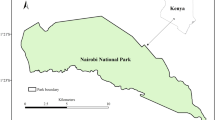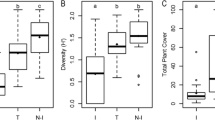Abstract
Invasive alien species can affect plant taxonomic and functional diversity. Multiple invasive alien species can co-invade the same plant community. However, the effects of such co-invasion on plant taxonomic and functional diversity are currently unclear. Our study aimed to estimate the effects of co-invasion by three Asteraceae invasive alien species (i.e., Conyza canadensis (L.) Cronquist, Conyza sumatrensis (S.F. Blake) Pruski and G. Sancho, and Solidago canadensis L.) on plant taxonomic and functional diversity in herbaceous ruderal communities in southern Jiangsu, China. The effects of these three invasive alien species under seven invasion combinations (including invasion by one invasive alien species, co-invasion by two invasive alien species, and co-invasion by these three invasive alien species) on plant taxonomic and functional diversity were investigated in a comparative field study of herbaceous ruderal communities. Niche differentiation mediated the functional divergence between these three invasive alien species and natives under all invasion combinations. These three invasive alien species significantly increased plant taxonomic diversity (especially plant diversity and richness) and plant functional diversity (especially Rao’s quadratic entropies) under all invasion combinations. The relative abundance of invasive alien species was significantly positively associated with plant functional diversity (especially community-weighted mean trait values and Rao’s quadratic entropy). The number of invasive alien species was significantly positively associated with plant taxonomic diversity (especially plant diversity and richness) and plant functional diversity (especially Rao’s quadratic entropies). Thus, co-invasion by these three invasive alien species may synergistically increase plant taxonomic diversity (especially plant diversity and richness) and functional diversity (especially Rao’s quadratic entropies).



Similar content being viewed by others
References
Bezeng BS, Savolainen V, Yessoufou K, Papadopulos AST, Maurin O, van der Bank M (2013) A phylogenetic approach towards understanding the drivers of plant invasiveness on Robben Island, South Africa. Bot J Linn Soc 172:142–152
Blossey B, Nuzzo V, Dávalos A, Mayer M, Dunbar R, Landis DA, Evans JA, Minter B (2021) Residence time determines invasiveness and performance of garlic mustard (Alliaria petiolata) in North America. Ecol Lett 24:327–336
Carboni M, Livingstone SW, Isaac ME, Cadotte MW (2021) Invasion drives plant diversity loss through competition and ecosystem modification. J Ecol 109:3587–3601
Cubino JP, Těšitel J, Fibich P, Lepš J, Chytrý M (2022) Alien plants tend to occur in species-poor communities. NeoBiota 73:39–56
Czortek P, Królak E, Borkowska L, Bielecka A (2020) Impacts of soil properties and functional diversity on the performance of invasive plant species Solidago canadensis L. on post-agricultural wastelands. Sci Total Environ 729:139077
Dimitrakopoulos PG, Koukoulas S, Galanidis A, Delipetrou P, Gounaridis D, Touloumi K, Arianoutsou M (2017) Factors shaping alien plant species richness spatial patterns across Natura 2000 special areas of conservation of Greece. Sci Total Environ 601–602:461–468
Driscoll DA (2017) Disturbance maintains native and exotic plant species richness in invaded grassy woodlands. J Veg Sci 28:573–584
Dyderski MK, Gdula AK, Jagodziński AM (2015) “The rich get richer” concept in riparian woody species: a case study of the Warta River Valley (Poznań, Poland). Urban for Urban Green 14:107–114
Erckie L, Adedoja O, Geerts S, van Wyk E, Boatwright JS (2022) Impacts of an invasive alien Proteaceae on native plant species richness and vegetation structure. S Afr J Bot 144:332–338
Fenesi A, Geréd J, Meiners SJ, Tóthmérész B, Török P, Ruprecht E (2015) Does disturbance enhance the competitive effect of the invasive Solidago canadensis on the performance of two native grasses? Biol Invasions 17:3303–3315
Funk JL, Standish RJ, Stock WD, Valladares F (2016) Plant functional traits of dominant native and invasive species in mediterranean-climate ecosystems. Ecology 97:75–83
Gross N, Boerger L, Duncan RP, Hulme PE (2013) Functional differences between alien and native species: do biotic interactions determine the functional structure of highly invaded grasslands? Funct Ecol 27:1262–1272
HilleRisLambers J, Yelenik SG, Colman BP, Levine JM (2010) California annual grass invaders: the drivers or passengers of change? J Ecol 98:1147–1156
Hulme PE (2008) Phenotypic plasticity and plant invasions: is it all Jack? Funct Ecol 22:3–7
Hulme PE, Bernard-Verdier M (2018) Comparing traits of native and alien plants: Can we do better? Funct Ecol 32:117–125
Jia S, Wu HP (2020) Zhenjiang yearbook: overview of zhenjiang. organized by zhenjiang municipal people’s government & written by Zhenjiang local records office. In: Yu W, Ye ZG, Sun WY, Yang ZH, Zong CJ, Qian JJ, Pan Y (eds) Publishing house of local records, Beijing, pp 14–15
Lanta V, Liancourt P, Altman J, Černý T, Dvorský M, Fibich P, Götzenberger L, Hornych O, Miklín J, Petřík P, Pyšek P, Čížek L, Doležal J (2022) Determinants of invasion by single versus multiple plant species in temperate lowland forests. Biol Invasions 24:2513–2528
Lavorel S, Grigulis K, McIntyre S, Williams NS, Garden D, Dorrough J, Berman S, Quétier F, Thébault A, Bonis A (2008) Assessing functional diversity in the field-methodology matters! Funct Ecol 22:134–147
Lenda M, Skórka P, Knops J, Żmihorski M, Gaj R, Moroń D, Woyciechowski M, Tryjanowski P (2019) Multispecies invasion reduces the negative impact of single alien plant species on native flora. Divers Distrib 25:951–962
Margalef R (1951) Diversidad de especies en las comunidades naturales. Barc Publ Ins Biol Apl 6:59–72
Mason NW, MacGillivray K, Steel JB, Wilson JB (2003) An index of functional diversity. J Veg Sci 14:571–578
Matevski D, Schuldt A (2021) Tree species richness, tree identity and non-native tree proportion affect arboreal spider diversity, abundance and biomass. For Ecol Manage 483:118775
Montgomery WI, Lundy MG, Reid N (2012) ‘Invasional meltdown’: evidence for unexpected consequences and cumulative impacts of multispecies invasions. Biol Invasions 14:1111–1125
O’Leary B, Burd M, Venn SE, Gleadow R (2018) Integrating the passenger–driver hypothesis and plant community functional traits to the restoration of lands degraded by invasive trees. For Ecol Manage 408:112–120
Pakeman RJ, Hewison RL, Lewis RJ (2017) Linking functional traits and species preferences to species’ abundance and occupancy trends through time to identify habitat changes in coastal ecosystems. Perspect Plant Ecol Evol Syst 27:35–44
Petruzzellis F, Tordoni E, Tomasella M, Savi T, Tonet V, Palandrani C, Castello M, Nardini A, Bacaro G (2021) Functional differentiation of invasive and native plants along a leaf efficiency/safety trade-off. Environ Exp Bot 188:104518
Pianka ER (1973) The structure of lizard communities. Annu Rev Ecol Syst 4:53–74
Pielou EC (1966) The measurement of diversity in different types of biological collections. J Theor Biol 13:131–144
Rao CR (1982) Diversity and dissimilarity coefficients: an unified approach. Theor Popul Biol 21:24–43
Richards CL, Bossdorf O, Muth NZ, Gurevitch J, Pigliucci M (2006) Jack of all trades, master of some? On the role of phenotypic plasticity in plant invasions. Ecol Lett 9:981–993
Ricotta C, Moretti M (2011) CWM and Rao’s quadratic diversity: a unified framework for functional ecology. Oecologia 167:181–188
Rybiński W, Garczyński S (2004) Influence of laser light on leaf area and parameters of photosynthetic activity in DH lines of spring barley (Hordeum vulgare L.). Int Agrophys 18:261–267
Shannon CE, Weaver W (1949) The mathematical theory of communication. University of Illinois Press, Urbana, Illinois, pp 1–117
Sheppard CS (2019) Relative performance of co-occurring alien plant invaders depends on traits related to competitive ability more than niche differences. Biol Invasions 21:1101–1114
Simpson EH (1949) Measurement of diversity. Nature 163:688
Tordoni E, Petruzzellis F, Nardini A, Savi T, Bacaro G (2019) Make it simpler: alien species decrease functional diversity of coastal plant communities. J Veg Sci 30:498–509
Trevenen EJ, Veneklaas EJ, Teste FP, Dobrowolski MP, Mucina L, Renton M (2022) Positive heterospecific interactions can increase long-term diversity of plant communities more than negative conspecific interactions alone. Funct Ecol 36:159–173
Vujanović D, Losapio G, Milić S, Milić D (2022) The impact of multiple species invasion on soil and plant communities increases with invasive species co-occurrence. Front Plant Sci 13:875824
Wang CY, Liu J, Xiao HG, Zhou JW, Du DL (2016) Floristic characteristics of alien invasive seed plant species in China. An Acad Bras Ciênc 88:1791–1797
Wang S, Wei M, Wu BD, Jiang K, Du DL, Wang CY (2019) Degree of invasion of Canada goldenrod (Solidago canadensis L.) plays an important role in the variation of plant taxonomic diversity and community stability in eastern China. Ecol Res 34:782–789
Wang CY, Wei M, Wang S, Wu BD, Cheng HY (2020) Erigeron annuus (L.) Pers and Solidago canadensis L. antagonistically affect community stability and community invasibility under the co-invasion condition. Sci Total Environ 716:137128
Wang CY, Cheng HY, Wang S, Wei M, Du DL (2021a) Plant community and the influence of plant taxonomic diversity on community stability and invasibility: a case study based on Solidago canadensis L. Sci Total Environ 768:144518
Wang CY, Cheng HY, Wei M, Wang S, Wu BD, Du DL (2021b) Plant height and leaf size: Which one is more important in affecting the successful invasion of Solidago canadensis and Conyza canadensis in urban ecosystems? Urban for Urban Green 59:127033
Wang CY, Cheng HY, Wu BD, Jiang K, Wang S, Wei M, Du DL (2021c) The functional diversity of native ecosystems increases during the major invasion by the invasive alien species, Conyza Canadensis. Ecol Eng 159:106093
Wang CY, Yu YL, Cheng HY, Du DL (2022) Which factor contributes most to the invasion resistance of native plant communities under the co-invasion of two invasive plant species? Sci Total Environ 813:152628
Wu BD, Zhang HS, Jiang K, Zhou JW, Wang CY (2019) Erigeron canadensis affects the taxonomic and functional diversity of plant communities in two climate zones in the North of China. Ecol Res 34:535–547
Xu HW, Liu Q, Wang SY, Yang GS, Xue S (2022) A global meta-analysis of the impacts of exotic plant species invasion on plant diversity and soil properties. Sci Total Environ 810:152286
Yan XL, Liu QR, Shou HY, Zeng XF, Zhang Y, Chen L, Liu Y, Ma HY, Qi SY, Ma JS (2014) The categorization and analysis on the geographic distribution patterns of Chinese alien invasive plants. Biodivers Sci 22:667–676
Yu YL, Cheng HY, Wang S, Wei M, Wang CY, Du DL (2022) Drought may be beneficial to the competitive advantage of Amaranthus spinosus. J Plant Ecol 15:494–508
Acknowledgements
We are very grateful to the anonymous reviewer for the insightful and constructive comments that greatly improved the clarity of this manuscript.
Funding
This study was funded by Open Science Research Fund of Key Laboratory of Forest Plant Ecology, Ministry of Education, Northeast Forestry University, China (Grant No.: K2020B02), Special Research Project of School of Emergency Management, Jiangsu University (Grant No.: KY-C-01), National Natural Science Foundation of China (Grant No.: 32071521), Carbon Peak and Carbon Neutrality Technology Innovation Foundation of Jiangsu Province (Grant No.: BK20220030), and Jiangsu Collaborative Innovation Center of Technology and Material of Water Treatment (no grant number).
Author information
Authors and Affiliations
Corresponding authors
Ethics declarations
Conflict of interest
The authors declare that they have no conflict of interest.
Supplementary Information
Below is the link to the electronic supplementary material.
Rights and permissions
Springer Nature or its licensor (e.g. a society or other partner) holds exclusive rights to this article under a publishing agreement with the author(s) or other rightsholder(s); author self-archiving of the accepted manuscript version of this article is solely governed by the terms of such publishing agreement and applicable law.
About this article
Cite this article
Li, C., Li, Y., Xu, Z. et al. The effects of co-invasion by three Asteraceae invasive alien species on plant taxonomic and functional diversity in herbaceous ruderal communities in southern Jiangsu, China. BIOLOGIA FUTURA (2024). https://doi.org/10.1007/s42977-024-00202-w
Received:
Accepted:
Published:
DOI: https://doi.org/10.1007/s42977-024-00202-w




